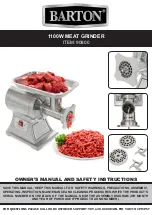
3
MN903
Grounding Instructions
WARNING: Be sure the system is properly grounded before applying power. Do not apply power before you ensure that
grounds are connected. Electrical shock can cause serious or fatal injury. Follow the National Electrical Code
(NEC) and local codes for the safe installation of this equipment.
1. All grounded, cord-connected grinders:
In the event of a malfunction or breakdown, grounding provides a path of least resistance for electric current to reduce
the risk of electric shock. This grinder is equipped with an electric cord having an equipment-grounding conductor
and a grounding plug. The plug must be plugged into a matching outlet that is properly installed and grounded in
accordance with all local codes and ordinances. Do not modify the plug provided. If it will not fit the outlet, have the
proper outlet installed by a qualified electrician.
Improper connection of the equipment-grounding conductor can result in a risk of electric shock. The “Green”
insulated wire (with or without yellow stripes) is the equipment-grounding conductor. If repair or replacement of the
electric cord is necessary, do not connect the equipment-grounding conductor to a live terminal.
Check with a qualified electrician or serviceman if the grounding instructions are not completely understood, or if in
doubt as to whether the tool is properly grounded.
Use only 3-wire extension cords that have 3-prong grounding plugs and 3-pole receptacles that accept the tool’s plug.
Repair or replace damaged or worn cord immediately.
2. Grounded, cord-connected grinders intended for use on a supply circuit having a nominal rating less than 150 volts:
This grinder is intended for use on a circuit that has an outlet that looks like the one illustrated in Figure A or B.
Figure A
Grounding
Blade
Figure B
Grounding
Blade
Cover of
Grounded
Outlet Box
3. Permanently connected grinders:
This grinder should be connected to a grounded, metal, permanent wiring system; or to a system having an
equipment-grounding conductor.
Operation
WARNING: Do not operate this grinder until you are sure that you are completely familiar with the safe operation of the
grinder, all accessories and safety equipment. Improper use can lead to severe injury. This manual defines proper
use of this equipment. Before using this equipment for any other use, please consult Baldor. Contact Baldor if you
do not understand any procedure or operation concerning this grinder or this manual.
WARNING: When starting a grinder for the first time, or after installing a replacement grinding wheel, it is most important
that the operator stand aside for at least one minute of rotation at full speed. This is the correct practice since
grinding wheels can disintegrate if they have received damage during shipping or handling.
Check that the On-Off switch is in the “OFF” position, and the grinding wheel and wheel move freely. When starting the
grinder for the first time or after replacing a wheel, it is important that the operator stand aside for at least one minute of
operation at speed. This will ensure that operation will be safe from debris. After connecting grinder to power source, turn
switch on. Grinder should come up to speed smoothly and without vibration. If grinder does
not, shut grinder off immediately and determine reason.
As grinding wheel wears, maintain 1/8” or less clearance between tool rest and grinding wheel and spark arrestor and
grinding wheel.
Grind on grinding face (periphery) of wheels only.
Maintenance
WARNING: Prevent electrical shock hazard and accidental machine operation. Always disconnect grinder from the power
source before servicing, changing accessories (such as wheels, tool rest, spark arrestor, etc.) or before
performing maintenance.
WARNING: Never install a wheel that is damaged, such as a chip or crack on any surface. A damaged wheel can disintegrate
while rotating at a high RPM or when work is placed against the wheel. This can severely harm the operator or
others in the area.
Replace worn grinding wheel as necessary. The grinding wheel should be replaced after the diameter is reduced by 2
inches from original size. When replacing a worn wheel, remove all grinding dust from wheel guard.
Motor and pulley bearings are lubricated for life and do not require additional lubrication.
Replacement wheels may be purchased directly from your local industrial supply dealers, abrasive dealers, tool dealers, etc.
Remove grinding dust from exhaust ports to prevent accumulation.
Replace damaged parts immediately to maintain safety of machine.
Table 1 Minimum Gauge Wire Size
Ampere Rating
Volts
Total Length of Cord (Cord + Extension, in Feet)
115V
25
50
100
150
230V
50
100
200
300
More Than
Not More Than
AWG
0
6
18
16
16
14
6
10
18
16
14
12
10
12
16
16
14
12
12
16
14
12
Not Recommended






















